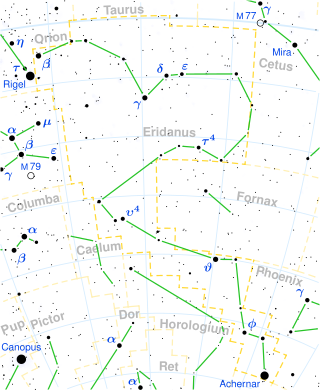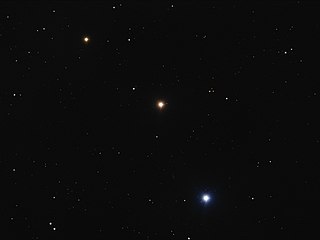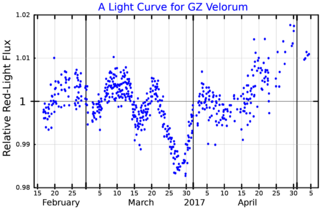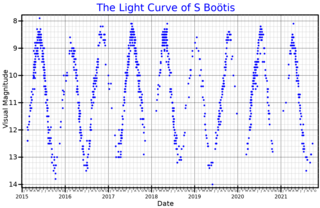65 Andromedae, abbreviated 65 And, is a single, orange-hued star in the northern constellation of Andromeda. With an apparent magnitude of 4.73, it is visible to the naked eye. The distance to 65 And can be derived from its annual parallax shift of 7.5 mas, which yields a range of around 440 light years. At that distance, its brightness is relatively lowered primarily by the inverse square law but also by an extinction of 0.16 magnitude due to interstellar dust. The star is moving closer to the Earth with a heliocentric radial velocity of −5 km/s.
10 Andromedae, abbreviated 10 And, is an astrometric binary star system in the northern constellation of Andromeda. 10 Andromedae is the Flamsteed designation. It has an apparent visual magnitude of approximately 5.81, which means it is faintly visible to the naked eye. Based upon an annual parallax shift of 6.6 mas, it is located 492 light years away. The system is moving toward the Earth with a heliocentric radial velocity of −1.1 km/s.
7 Aquarii, abbreviated 7 Aqr, is a binary star system in the zodiac constellation of Aquarius. 7 Aquarii is the Flamsteed designation. It is visible to the naked eye with an apparent visual magnitude of 5.5; the brighter component is baseline magnitude 5.62 while the faint secondary is magnitude 11.4. As of 2002, the pair had an angular separation of 2.10″ along a position angle of 165°. The distance to this system, based upon an annual parallax shift of 4.9 mas, is around 660 light years. It is moving closer to the Earth with a heliocentric radial velocity of −32 km/s.

6 Boötis is a binary star system in the northern constellation of Boötes, located around 460 light years away from the Sun. It has the Bayer designation e Boötis; 6 Boötis is the Flamsteed designation. The system is visible to the naked eye as a faint, orange-hued star with an apparent visual magnitude of 4.92. It is moving closer to the Earth with a heliocentric radial velocity of −3 km/s.
Phi1 Cancri, Latinised from φ1 Cancri, is a solitary, orange-hued star in the constellation Cancer. It is faintly visible to the naked eye with an apparent visual magnitude of +5.57. Based upon an annual parallax shift of 8.74 mas, it is approximately 370 light-years from the Sun.
60 Cancri is a star in the zodiac constellation Cancer, located about 850 light years away from the Sun. It is visible to the naked eye as a faint, orange-hued star with an apparent visual magnitude of +5.44. 60 Cancri is situated near the ecliptic, so it is subject to the occasional occultation by the Moon. It is moving away from the Earth with a heliocentric radial velocity of +25 km/s.
6 Canis Minoris is a star in the equatorial constellation of Canis Minor, located around 570 light years away from the Sun. It is visible to the naked eye as a faint, orange-hued star with an apparent visual magnitude of +4.55. This object is moving closer to the Earth with a heliocentric radial velocity of −16.3 km/s. Kinematically, it is a member of an outlying group belonging to the Ursa Major flow of the Sirius supercluster.

R Horologii is a red giant star approximately 760 light-years away in the southern constellation of Horologium. It is a Mira variable with a period of 404.83 days, ranging from apparent magnitude 4.7 to 14.3—one of the largest ranges in brightness known of stars in the night sky visible to the unaided eye. The star is losing mass at the rate of 5.9×10−7 M☉·y−1.

Psi7 Aurigae, Latinized from ψ7 Aurigae, is a star in the northern constellation of Auriga. It is a dim, naked eye star with an apparent visual magnitude of 5.02. Based upon Gaia Data Release 2 parallax values, it is approximately 330 light-years from Earth.

Tau4 Eridani is a binary star system in the constellation Eridanus. It is visible to the naked eye with an apparent visual magnitude of 3.65. The distance to this star can be estimated using the parallax method, which yields a value of roughly 300 light years.
HD 197036 is a single star in the northern constellation Cygnus. It has an absolute magnitude of −1.15 and an apparent magnitude of 6.61, below the max naked eye visibility. Located 1,310 light years away, it is approaching Earth with a heliocentric radial velocity of −15 km/s.
24 Vulpeculae is a single, yellow-hued star in the northern constellation of Vulpecula. It is faintly visible to the naked eye with an apparent visual magnitude of 5.30. The distance to this star can be estimated from its annual parallax shift of 7.9700±0.0674, which yields a separation of roughly 409 light years. It is moving further away with a heliocentric radial velocity of +15 km/s.
HD 200661 is a solitary star in the equatorial constellation Equuleus. It has an apparent magnitude of 6.41, placing it near the max naked eye visibility. The star is situated at a distance of 430 light years but is approaching with a heliocentric radial velocity of −12.1 km/s.

6 Draconis is a single-lined spectroscopic binary star system in the northern constellation of Draco, located about 430 light years away from the Sun. It is visible to the naked eye as an orange-hued star with an apparent visual magnitude of 4.95. The system is moving further from the Earth with a heliocentric radial velocity of 3 km/s.
111 Herculis is a suspected astrometric binary star system located 92 light years from the Sun in the northern constellation Hercules. It is visible to the naked eye as a faint, white-hued point of light with an apparent visual magnitude of 4.34. The system is moving nearer to the Earth with a heliocentric radial velocity of −45 km/s, and may come as close as 37 light-years in 537,000 years.
Kappa Librae, Latinized from κ Librae, is the Bayer designation for a star system in the zodiac constellation of Libra. Its apparent visual magnitude is 4.72, so it can be seen with the naked eye. The annual parallax shift of 10.57 mas indicates it is roughly 310 light years away. It is positioned 0.02 degrees south of the ecliptic.

GZ Velorum is a single, orange-hued star in the southern constellation of Vela. It is a faint star but visible to the naked eye, having an apparent visual magnitude of 4.58. The star is located around 1,300 light years from Earth, as determined from its annual parallax shift of 2.4 mas. It is moving further away with a heliocentric radial velocity of +13 km/s.
HD 89998 is a single star in the southern constellation of Vela. It is a faint star but visible to the naked eye with an apparent visual magnitude of 4.82. The distance to HD 89998, as determined from its annual parallax shift of 15.9 mas, is 205 light years. The star is moving further from the Earth with a heliocentric radial velocity of +21 km/s, having come within 140 ly some 1.552 million years ago.

S Boötis is a Mira variable in the constellation Boötes. It ranges between magnitudes 7.8 and 13.8 over a period of approximately 270 days. It is too faint to be seen with the naked eye, however when it is near maximum brightness it can be seen with binoculars.
HD 166006, also known as HR 6778, is a solitary orange-hued star located in the southern constellation Telescopium. It has an apparent magnitude of 6.07, making it barely visible to the naked eye. Based on Gaia DR2 parallax measurements, the object is located 582 light years away. It is currently approaching the Solar System with a somewhat constrained heliocentric radial velocity of −15 km/s.








